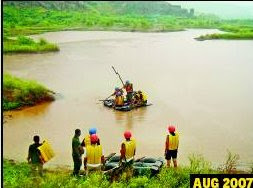Blogs >> Miscellaneous >>
Death of a Lake


If
still more evidence was required, here it is. A large lake, that till
two years ago brimmed with water, has also dried up completely in
Dhauj, just 3km from the Sirohi and Khori Jamalpur mines, ramming home
yet again the correlation between mining in the Aravalis and the
drought in the area. The evidence is there for anyone who cares to see.
It’s there at the Dhauj Jheel, Badkhal Lake, Surajkund, Damdama Lake
and scores of smaller water bodies in the region. But the Haryana
government, which could actually roll back the water crisis, is looking
the other way. Far from preventing mining in these ravaged mines, even
after the expiry of a seven-year lease, it is set to set to extend
mining there by two years. That is, unless the Punjab and Haryana High
Court, which is scheduled to take up the issue on Wednesday, rejects
the state government and the miner lobby’s argument that construction
material is getting scarce in Delhi and steps up to save the
Aravalis.It had been reported how virtually all big projects in the
Capital were sourcing their materials from Rajasthan and were tied into
long-term contracts, which would not make an impact on prices. The high
court would, in any case, be aware that the Supreme Court passed a
status-quo order on February 13, which means the current situation,
including expiry of lease on the these two mines, can’t be changed
until the apex court has taken a view on the larger issue of the
ecological devastation of this entire region. On paper, they are
breeding fish here Faridabad: Dhauj Jheel, a large lake just 3km from
Sirohi and Khori Jamalpur mines in Faridabad, has for the first time in
its 70-year history gone completely dry with ugly cracks on its bed
telling an eloquent story of water famine, claim locals. Satellite
imagery, included in the Supreme Court-appointed Central Empowered
Committee, shows that only last May the lake was full. Locals say the
lake dried up in three months. Interestingly, the lake belongs to the
Haryana fisheries department which has leased it out for fishing. But
what’s really being ‘‘fished’’ out of here is sand — truckloads of it —
that has damaged the waterretention capacity of the soil. All that
remains of the lake that once spread over 100 acres is a tiny, dirty
puddle on one side with truck marks all around. As per the records of
the fisheries department, the dry bed has been leased out to a private
agency for pisciculture. P V Singh director (fisheries) says: ‘‘There
are prospects of good rains so there’s fish culture happening there.’’
On being told that there is no water and sand was being scooped out of
the lake bed, he replied: ‘‘If there is no water then that is not my
lookout, mining department will need to check that.’’ Mining officials
claimed it was a ‘‘local problem’’ but promised to get it checked
provided ‘‘it is not reported”. Irrigation department officials said
that the dam was constructed to prevent the huge run off rainwater from
flooding the agriculture fields and villages in low-lying areas and
also to ensure a year-long supply of water and groundwater recharge.
The water markings on the dam are an indication of how much water the
reservoir once held. The unorganised mining has left small patches of
exposed groundwater in some places (the water level is at 17 feet) —
yet another means of ground water depletion in an area where countless
tubewells have gone dry since 2002 when mining commenced. Locals have
turned incidental profiteers with some charging trucks at the rate of
Rs 100 per trip to let them pass through land they own. Locals and
district administration officials said there were signs of alarming
depletion of the water level over 7-8 years. A Central Ground Water
Board report submitted to the Supreme Court in 2004 said: ‘‘... the
drainage pattern of the area has been modified due to haphazard mining
and dumping of waste material which has bearing on natural path of
ground water flow in the area.’’ The effect on drainage pattern was
mentioned in a Supreme Court order of 2006 too while delivering the
judgement on a case filed by M C Mehta. A forest department official
explained: ‘‘Since rainwater is the only source for such lakes in the
entire Aravali region, till the time the rainwater catchment area
remained intact, run off rainwater from 10 km around the dam filled
Dhauj. The height of Dhauj Lake is more than the mining areas of Khori
and Sirohi so depletion of groundwater from the mining pits affected
the recharge rate here. Rainwater hardly reaches the lake now as
because of man-made changes in the rock around, either the courses have
altered or the water ends up filling only the mining pits.’’ Locals say
there have been attempts to ‘‘mine’’ the rockclimbing site of Dhauj too
but some local land-owners have resisted that. The situation, the
official added is now so bad that even if all the natural rainwater
courses are clear, it will take decades to fill the lake because of the
havoc wreaked by mining and the altered soil character. In this
situation, can mining for another two years be allowed here?
|
|
